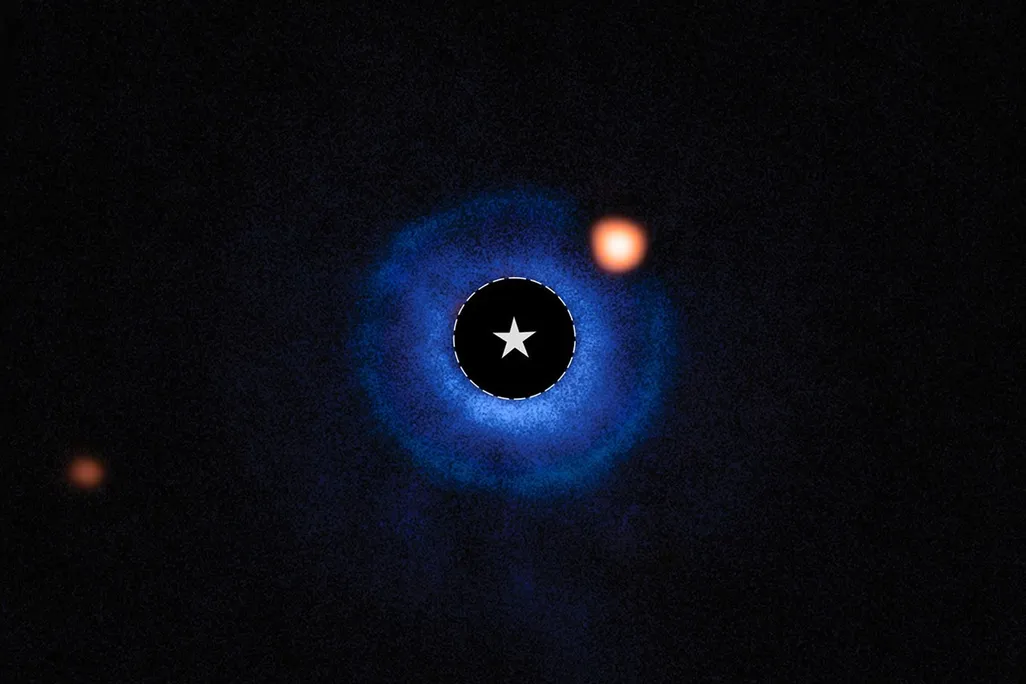2025-06-27 13:44:00
www.smithsonianmag.com
Researchers identified the likely planetary candidate’s infrared light after blocking out its host star’s overwhelming glare

In this image, light from the star TWA 7 has been subtracted. The potential exoplanet TWA 7 b is the orange circle within the blue debris disk.
NASA, ESA, CSA, Anne-Marie Lagrange (CNRS, UGA), Mahdi Zamani (ESA / Webb)
Astronomers using the James Webb Space Telescope (JWST) have identified a faint source of infrared light in a disk of debris surrounding a young star called TWA 7, approximately 111 light-years away from Earth. The source, they say, is probably an exoplanet. If confirmed, it would mark the telescope’s first direct discovery of a planet outside our solar system.
Researchers have discovered almost all of the thousands of known exoplanets with indirect methods, per the Guardian’s Hannah Devlin, such as by detecting the planet’s slight shadow when it orbits in front of its host star. But in a new study published Wednesday in the journal Nature, astronomers describe the first time the JWST has captured a photo of an exoplanet.
Imaging a planet around a distant star is difficult, since the world is easily outshined by its host. “The basic problem is that the star is bright and the planet is very faint,” Anne-Marie Lagrange, lead author of the study and an astrophysicist at the French National Center for Scientific Research, tells Science News’ Adam Mann.
Lagrange and her colleagues got around the starlight problem by using the JSWT’s coronagraph—an instrument that blocks out powerful starlight to make it easier to spot dimmer objects nearby. After negating the glare that still managed to sneak through with advanced image processing, the JSWT’s image revealed a faint infrared source near the star TWA 7.
Fun fact: James Webb Space Telescope’s exoplanet discovery
While the new study marks the first time the James Webb Space Telescope has discovered a new exoplanet through direct imaging, the observatory confirmed an earlier discovery of a potential exoplanet in January 2023.
Although there is a slight possibility that the newly detected infrared source might be a background galaxy—about an 0.34 percent chance—the researchers argue that most evidence indicates the presence of an undocumented exoplanet, dubbed TWA 7 b, with around the same mass as Saturn. Initial observations identify TWA 7 b as a young planet close to 120 degrees Fahrenheit, located within a gap in one of the debris disk’s three dust rings. The distance between the potential planet and the star is around 50 times the distance of Earth from our sun.
“Our observations reveal a strong candidate for a planet shaping the structure of the TWA 7 debris disk, and its position is exactly where we expected to find a planet of this mass,” Lagrange says in a statement. Its mass makes it even more special, given that it is about ten times lighter than any directly imaged exoplanet, showcasing the ability of the space telescope’s instruments.
According to Space.com’s Robert Lea, astronomers have been interested in TWA 7 for a long time, because from Earth, we see the star’s surrounding debris disk head-on, as opposed to from its narrow side. This view enabled previous researchers to identify gaps within the disk, which indirectly hinted at the presence of undiscovered planets.
If the infrared source spotted by the JWST really is an exoplanet, it would also represent the first discovery of a planet directly associated with shaping a debris disk around a star.
To further support their observations, Lagrange and her colleagues ran computer models that visualized the potential planetary system. The simulations yielded images that aligned with the ones captured by the telescope. “This was really why we were confident that there was a planet,” Lagrange says to Science News.
Ultimately, the JWST’s imaging of an exoplanet with a mass similar to Saturn’s holds implications for understanding planetary systems, including the one we reside in, co-author Mathilde Malin, an astrophysicist at the Space Telescope Science Institute, says in the statement.
“Webb opens a new window—in terms of mass and the distance of a planet to the star—of exoplanets that had not been accessible to observations so far,” Lagrange explains to Will Dunham at Reuters. “This is important to explore the diversity of exoplanetary systems and understand how they form and evolve.”
Keep your files stored safely and securely with the SanDisk 2TB Extreme Portable SSD. With over 69,505 ratings and an impressive 4.6 out of 5 stars, this product has been purchased over 8K+ times in the past month. At only $129.99, this Amazon’s Choice product is a must-have for secure file storage.
Help keep private content private with the included password protection featuring 256-bit AES hardware encryption. Order now for just $129.99 on Amazon!
Help Power Techcratic’s Future – Scan To Support
If Techcratic’s content and insights have helped you, consider giving back by supporting the platform with crypto. Every contribution makes a difference, whether it’s for high-quality content, server maintenance, or future updates. Techcratic is constantly evolving, and your support helps drive that progress.
As a solo operator who wears all the hats, creating content, managing the tech, and running the site, your support allows me to stay focused on delivering valuable resources. Your support keeps everything running smoothly and enables me to continue creating the content you love. I’m deeply grateful for your support, it truly means the world to me! Thank you!
|
BITCOIN
bc1qlszw7elx2qahjwvaryh0tkgg8y68enw30gpvge Scan the QR code with your crypto wallet app |
|
DOGECOIN
D64GwvvYQxFXYyan3oQCrmWfidf6T3JpBA Scan the QR code with your crypto wallet app |
|
ETHEREUM
0xe9BC980DF3d985730dA827996B43E4A62CCBAA7a Scan the QR code with your crypto wallet app |
Please read the Privacy and Security Disclaimer on how Techcratic handles your support.
Disclaimer: As an Amazon Associate, Techcratic may earn from qualifying purchases.



















































































![Conquest of Space / I Married a Monster from Outer Space [Blu-ray]](https://techcratic.com/wp-content/uploads/2025/09/81Yx1UahVuL._SL1500_-360x180.jpg)






/https://tf-cmsv2-smithsonianmag-media.s3.amazonaws.com/accounts/headshot/Margherita_Bassi.png)














